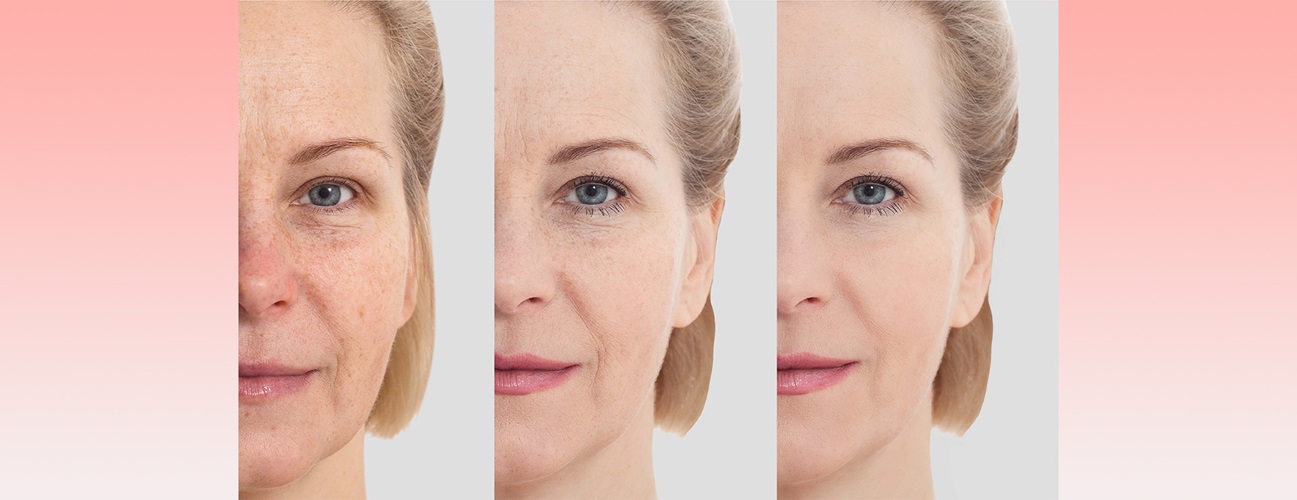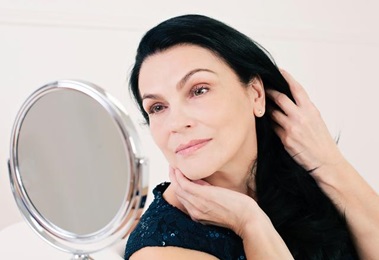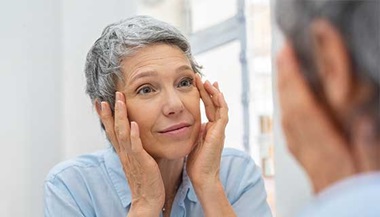How Facial Rejuvenation Procedures Can Improve Aging Skin
Featured Expert:
The natural aging process can take a toll on every part of the body, including the skin. From forehead wrinkles to under-eye hollows, aging skin on the face is a common concern for many people. Kofi Boahene, M.D., director of facial plastic and reconstructive surgery at Johns Hopkins Medicine, explains how your skin ages and which facial rejuvenation procedures might be right for you.
What are the signs of an aging face?
Every person’s face ages differently, but there are telltale signs that facial skin is losing some of its firmness and elasticity. “A youthful face has certain characteristics,” explains Boahene, “including a defined neck and jawline, firm skin, high brows, short eyelids and an egg-like shape.”
Aging usually starts in the eyelids and around the eyes. The skin around the eyes is the thinnest in the face. As you age, you may notice dark circles and under-eye hollows, resulting in eyes that look sunken. Some people also develop puffiness beneath the eyes, drooping or excess eyelid skin or fine wrinkles at the corners of the eyes (crow’s feet).
The fat in the face also starts to move downward, especially in the cheeks, says Boahene. The skin might look droopy around the nose, cheeks and jawline. Many people develop wrinkles, lines and folds, including deep frown lines above or around their lips. Then, fat around the jaw and neck move down and people get “jowls.”
Other common signs of an aging face include:
- Changes in the contour of the face (lower part becomes wider, face becomes squarer)
- Dull skin texture
- Larger pores
- Less definition
- Pigment changes (skin discoloration)
How does the skin age?
The skin has three layers: the epidermis, dermis and hypodermis. Most age-related skin changes involve the dermis, which is the middle layer of skin. The dermis contains a lot of the substances that keep skin firm and smooth, such as collagen, elastin and hyaluronic acid. Around age 35, we start to lose these substances and the skin becomes lax.
There’s also a layer of fat under the skin called subcutaneous fat, which gives your face volume and definition. As the skin loses collagen, elastin and other substances that keep it firm, the fat pads around the eyelids, cheeks, temples and chin shift downward. As a result, the face loses its contours and it wrinkles, and lines and loose skin start to develop.
Are there ways to improve the appearance of an aging face?
You can improve the look of an aging face in a variety of ways, both nonsurgically and surgically. Some of the most common goals for facial rejuvenation include:
- Restore volume and face contour
- Reduce the appearance of under-eye wrinkles and hollows
- Correct forehead wrinkles and sagging brows
- Tighten sagging skin around the neck and jaw
- Correct pigmentary changes
Achieving a Natural-Looking Facelift
Restore Volume and Face Contour
Dermal fillers are one of the most common nonsurgical treatments to help create smoother, firmer skin on the face and reduce the look of wrinkles. Fillers typically contain collagen or hyaluronic acid, two of the substances that are essential for youthful skin. Both fillers offer temporary results, but they are quick in-office procedures. “Injectables and fillers are a good first step for someone who wants to address the early signs of skin aging, such as fine lines or mildly sagging skin,” explains Boahene.
Facial fat grafting, or a fat transfer, is a more permanent solution to drooping skin and lost facial volume. A surgeon takes fat from elsewhere in your body (usually the belly or thighs) and injects it to select areas on your face.
There are two types of fat transfers:
- Microfat grafting uses fat to plump areas of the face such as the cheeks, forehead and lips.
- Nanofat grafting involves processing microfat further to use for more targeted skin concerns such as:
- Improving skin texture
- Minimizing dark circles
- Reducing fine lines
- Reducing the appearance of acne scars
- Upper eyelid surgery repairs loose, sagging skin over the eyes. This can usually be performed under local anesthesia.
- Lower eyelid surgery improves drooping lower eyelids, reduces puffiness and bags under the eyes, and tightens excess skin and smooths wrinkles.
Reduce the Appearance of Under-Eye Wrinkles and Hollows
Nanofat injections can help improve the look of fine wrinkles around the eye, under-eye hollows and sunken eyes. But for sagging skin or puffiness around the eyes, you may need eyelid surgery.
Also called an eyelid lift (blepharoplasty) or eyelid rejuvenation, this surgery helps redefine the shape of an eye. The procedure can address problems on the upper eyelids, lower eyelids or both:
Blepharoplasty (Eyelid Surgery) | Q&A
Correct Forehead Wrinkles and Drooping Brows
Some injectables can smooth lines in the forehead and minimize wrinkles between the eyebrows. “These treatments might be right for people with dynamic wrinkles — fine wrinkles caused by facial expressions,” Boahene says. “But once the wrinkles become static, or etched deeply into your skin, you may need to consider dermal fillers or microfat grafting to fill them in.”
Injectables and fillers can’t correct a droopy brow. An eyebrow lift is a more effective and permanent solution to correct sagging brows. Also called a forehead lift, a brow lift removes excess fat and tightens skin and muscle tissue in the brow and forehead.
Tighten Sagging Skin Around the Neck and Jaw
The most effective treatment to tighten the skin around the jaw and neck, reducing the look of jowls, is neck lift surgery. A neck lift creates a smoother, firmer jawline. It restores facial definition without overtightening the face or giving it a pulled appearance. A neck lift:
- Removes excess fat in the lower face and under the chin
- Tightens loose neck skin
- Minimizes deep smile lines
Achieving a Natural-Looking Neck Lift
Correct Pigmentary Changes
Skin discoloration may be corrected with effective skin care products, chemical peels or laser treatment.
How do I maintain a youthful face after a cosmetic procedure?
After a cosmetic procedure, it’s important to:
- Stay out of the sun: Protect your face from sun exposure by wearing sunscreen with SPF 30 or higher, sunglasses and wide-brimmed hats when you are outside.
- Establish a skin care routine: Use face products with antioxidants, such as vitamin C. Antioxidants help remove free radicals that damage the skin. Apply products as instructed to make sure they are maximally absorbed.
- Get touch-ups as recommended by your doctor: Some people need touch-ups after facial rejuvenation procedures. Discuss with your doctor how long the effects of your facial rejuvenation procedure may last and when to consider a touch-up.









